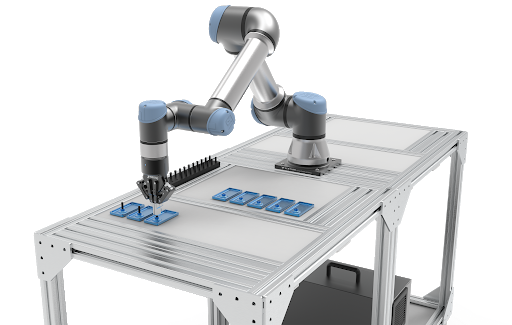Understanding the Minimum Viable Robotic Cell

Posted on Nov 22, 2017 7:00 AM. 4 min read time
What is a 'Minimum Viable Robotic Cell'? (Or 'Avoiding The Rube Goldberg Effect')
According to Guinness World Records (GWR), the largest Rube Goldberg machine in the world was created in Latvia back in 2016.
Designed to turn on Christmas lights, the complex device incorporated wheels, levers and balls, as well as a fan and coffee maker. The process consisted of 412 individual mechanical steps and took over a month to build. The task was completed In just under 5 minutes.
Of course, a light swtich could be flipped on or off in an instant by any semi-competent robot, but that's neither the point nor the fun of Rube Goldberg machines.
As GWR put it:
The principle of a Rube Goldberg is to complete a simple task in the most complicated way possible.
Rube Goldberg devices are a celebration of carefully-crafted absurdities, time-wasting inefficiencies, useless design and preposterous over-engineering.
.gif?width=428&height=302&name=Rube_Goldberg's_-Self-Operating_Napkin-_(cropped).gif) Image via Wikipedia.
Image via Wikipedia.
They are everything, in other words, that your 'Minimum Viable Robotic Cell' is not.
What is a 'Minimum Viable Robotic Cell'?
A minimum viable robotic cell (MVRC) is a robotic cell
with just enough features (and no more) that can reliably create value
for its customer. -- Lean Robotics, 2017
You don't want a manufacturing cell that's like some crazy Rube Goldberg machine. Your customers (the next station) won't tolerate it.
At the same time, you don't want to cut corners, or skimp on any important feature of cell development either.
Lean Robotics can help here by enabling you to create manufacturing cells that are safe, effective, and easy to deploy. In fact, one of the highlights of our 24-Hour Workshop Challenge earlier this year was the speed of deployment achieved using the Lean Robotics methodology.
The concept of an MVRC has its roots in the notion of a 'minimum viable product' --a common enough term in product development, that's used to describe a product with just enough features (and no more) to satisfy early customers, who then provide feedback
for future development.
Via Techopedia:
A minimum viable product (MVP) is a development technique in which a new product or website is developed with sufficient features to satisfy early adopters. The final, complete set of features is only designed and developed after considering feedback from the product's initial users.
Advantages of the MVRC
The work done during the Design and Integrate stages can only create value if the cell ends up working reliably in the operation stage.
Adding complexity could diminish the value that can be created by the robotic cell, because it may delay the launch date and reduce reliability.
Robotic cell design and integration almost always takes longer than expected. It’s sometimes tempting to add features along the way, but you should stick with what you need and avoid the “nice to have’s.”
The context in which your cell operates will probably change along the way. You can’t possibly know all the relevant information at the
beginning of the design stage—first because all the stakeholders will be learning throughout the deployment process (about robot
possibilities, limitations, effects on other factors, etc.), and second because the company’s environment—both physically and in the
business sphere—might be changing rapidly.
The more time it takes to deploy the robotic cell, the more likely it is that the context will have changed by the time it’s operating. That’s why the cell design should be kept flexible enough to remain open to future improvements.
Your robotic cell will need to evolve to keep up with future developments, so you should view the robotic cell deployment project not as a final destination, but as another step in your lean manufacturing journey.
Measure Value
It's important to measure how much value your robotic cell is producing for your customers. This is the basis of your evaluation of whether the robotic cell is doing its job the way you intended. It will also be a key metric to track as you aim for continuous cell improvement.
Project Managers, keeping 'the end in mind' from the outset and focusing on customer value requires you to
a) create an MVRC and
b) think about how you’ll measure the value it creates.
Make sure to visit the Lean Robotics website to learn more.







Leave a comment